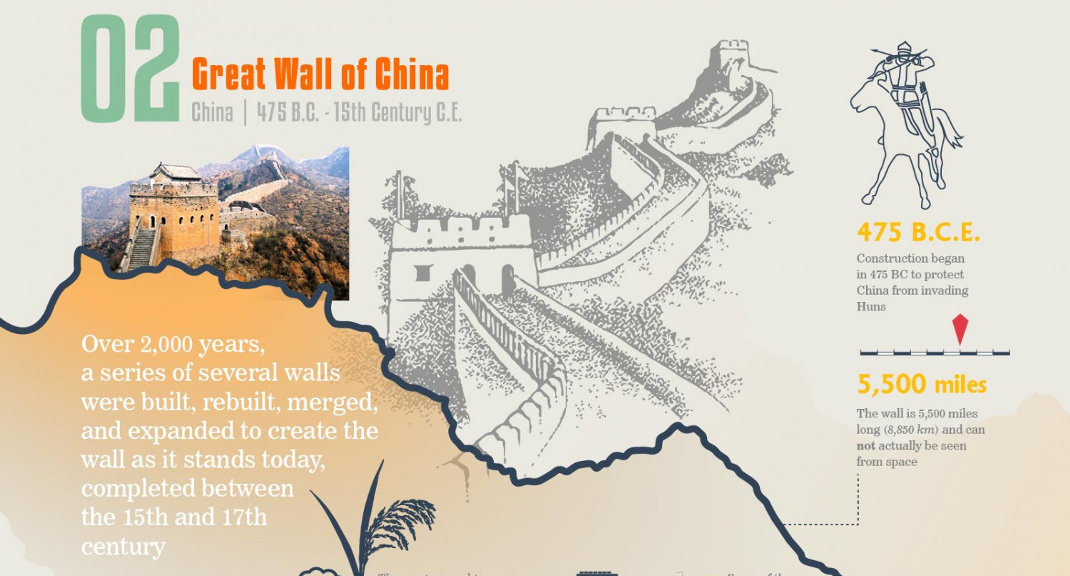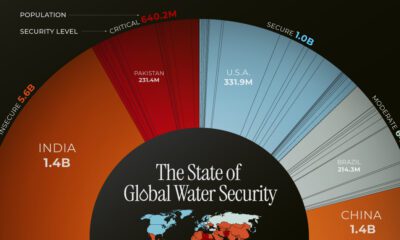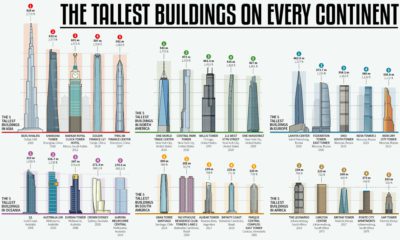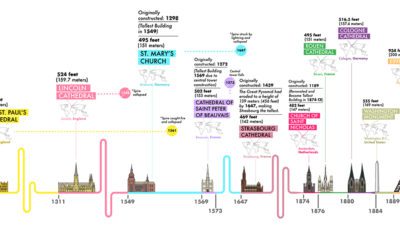Misc
The 10 Most Impressive Civil Engineering Projects of All Time

The 10 Most Impressive Civil Engineering Projects of All Time
With every day that passes, thousands of new civil engineering projects are completed around the globe. They might be as simple as building the foundation for a house or as complex as designing a suspension bridge that spans an entire river.
Once in a while, however, a very special type of civil engineering marvel gets finished that is earmarked to forever exist in a league of its own.
Civil Engineering Feats
Today’s infographic comes to us from Norwich University, and it counts down the 10 most impressive civil engineering projects ever completed by humanity.
These unique and extremely bold endeavors tend to exceed all normal standards of size, complexity, and manpower required. They transcend time and bestow wonder upon new generations, showing that incredible feats are possible with the right team, ideas, and expertise at hand.
Some of these projects were also included on the 1994 list of the Seven Wonders of the Modern World, put together by the American Society of Civil Engineers.
Meanwhile, the Great Pyramid is the only entry from the Seven Wonders of the Ancient World list.
Counting Down the Top 10
Here are the projects, going from #10 all the way to #1:
10. Qingdao Haiwan Bridge
This 26.4 mile (42.5 km) bridge was completed in 2011 in China, using 450,000 tons of steel and 3 million cubic yards of concrete.
9. Burj Khalifa
The world’s tallest skyscraper is one of many fascinating projects in Dubai. It reaches 2,717 ft (828 m) in height, almost a full 1,000 ft higher than One World Trade Center in New York.
8. English Channel Tunnel
This 31 mile (50 km) long tunnel is also up to 250 ft (76 m) deep, connecting England and France.
7. Golden Gate Bridge
This historic wonder connects San Francisco to the rest of the bay, and needed an incredible 600,000 rivets in its construction.
6. Hoover Dam
This dam formed the largest man-made lake in the Western Hemisphere, and it generates 4 billion kWh of energy per year.
5. Panama Canal
This 47 mile (77 km) long man-made canal was designed to connect the Atlantic and Pacific oceans to provide trade ships with passage between North and South America. It needed more than 60 million pounds of dynamite to dig.
4. Brooklyn Bridge
The first suspension bridge to use steel in its cables was also the longest in the world at the time of its construction.
3. Aqueduct of Segovia
This amazing aqueduct in Spain was made without the use of mortar, and is so well-preserved that it is still in use today.
2. Great Wall of China
What many people do not know about this enormous 5,500 mile (8,850 km) long wall is that the mortar connecting stones was made from rice flour.
1. Great Pyramid of Giza
This incredible creation is made of 2.3 million stone blocks, which required the constant labor of 30,000 people to build. It was the tallest man-made structure for more than 3,800 years.
A Final Note
The list represents the ranking as done by Norwich University’s civil engineering department, and surely there are other incredible feats that are missed by this ranking. Those would include projects like the Three Gorges Dam in China, the CN Tower, and many other worthy accomplishments.
Misc
How Hard Is It to Get Into an Ivy League School?
We detail the admission rates and average annual cost for Ivy League schools, as well as the median SAT scores required to be accepted.

How Hard Is It to Get Into an Ivy League School?
This was originally posted on our Voronoi app. Download the app for free on iOS or Android and discover incredible data-driven charts from a variety of trusted sources.
Ivy League institutions are renowned worldwide for their academic excellence and long-standing traditions. But how hard is it to get into one of the top universities in the U.S.?
In this graphic, we detail the admission rates and average annual cost for Ivy League schools, as well as the median SAT scores required to be accepted. The data comes from the National Center for Education Statistics and was compiled by 24/7 Wall St.
Note that “average annual cost” represents the net price a student pays after subtracting the average value of grants and/or scholarships received.
Harvard is the Most Selective
The SAT is a standardized test commonly used for college admissions in the United States. It’s taken by high school juniors and seniors to assess their readiness for college-level academic work.
When comparing SAT scores, Harvard and Dartmouth are among the most challenging universities to gain admission to. The median SAT scores for their students are 760 for reading and writing and 790 for math. Still, Harvard has half the admission rate (3.2%) compared to Dartmouth (6.4%).
| School | Admission rate (%) | SAT Score: Reading & Writing | SAT Score: Math | Avg Annual Cost* |
|---|---|---|---|---|
| Harvard University | 3.2 | 760 | 790 | $13,259 |
| Columbia University | 3.9 | 750 | 780 | $12,836 |
| Yale University | 4.6 | 760 | 780 | $16,341 |
| Brown University | 5.1 | 760 | 780 | $26,308 |
| Princeton University | 5.7 | 760 | 780 | $11,080 |
| Dartmouth College | 6.4 | 760 | 790 | $33,023 |
| University of Pennsylvania | 6.5 | 750 | 790 | $14,851 |
| Cornell University | 7.5 | 750 | 780 | $29,011 |
*Costs after receiving federal financial aid.
Additionally, Dartmouth has the highest average annual cost at $33,000. Princeton has the lowest at $11,100.
While student debt has surged in the United States in recent years, hitting $1.73 trillion in 2023, the worth of obtaining a degree from any of the schools listed surpasses mere academics. This is evidenced by the substantial incomes earned by former students.
Harvard grads, for example, have the highest average starting salary in the country, at $91,700.
-

 Real Estate2 weeks ago
Real Estate2 weeks agoVisualizing America’s Shortage of Affordable Homes
-

 Technology1 week ago
Technology1 week agoRanked: Semiconductor Companies by Industry Revenue Share
-

 Money2 weeks ago
Money2 weeks agoWhich States Have the Highest Minimum Wage in America?
-

 Real Estate2 weeks ago
Real Estate2 weeks agoRanked: The Most Valuable Housing Markets in America
-

 Business2 weeks ago
Business2 weeks agoCharted: Big Four Market Share by S&P 500 Audits
-

 AI2 weeks ago
AI2 weeks agoThe Stock Performance of U.S. Chipmakers So Far in 2024
-

 Misc2 weeks ago
Misc2 weeks agoAlmost Every EV Stock is Down After Q1 2024
-

 Money2 weeks ago
Money2 weeks agoWhere Does One U.S. Tax Dollar Go?















